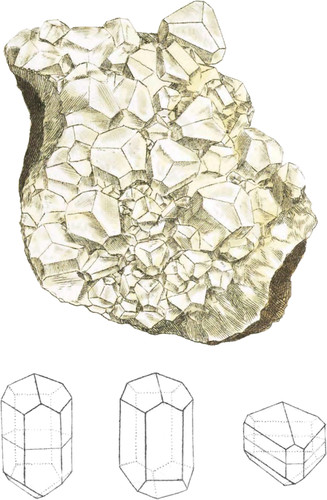 Enlarge
Enlarge
British Mineralogy
Carbonate of Lime
- Div. 1. Crystallized.
- Syn. Chaux carbonatée. Bournon, Traité, ii. 12, fig. 37.
Mackles or Hemitropes are some much rarer than others; that of tab. 316 is very rare, my worthy friend the Count de Bournon had not met with that of tab. 315, and it may be considered a valuable variety, seeing that he has found 698 other varieties of crystals. The present is also remarkable for being mixed in in the group among other forms, which is some variation from the general uniformity of groups of crystals which are commonly of the same variety. The Commoner crystals are six-sided prisms terminated by three-sided pyramids, so placed as to render the faces of each other pentangular. See the right hand figure. The mackled crystals differ from these in the form of the faces of the prism, winch are alternately four- and six-sided. See the middle figure. In some the four-sided faces are much enlarged in a lateral direction, and the six-sided ones proportionally diminished, thus rendering the general form of the crystal triangular. See the left hand figure. It commonly happens that the small six-sided face is opaque on ithe surface, and exhibits a slightly laminated structure, as if it had been added after the rest of the crystal was formed. This mackle is formed by supposing the hexaëdral prism with pentangular faces to be divided into two halves by a plane passing horizontally through its middle, and separating each of its sides into two portions, one rectangular, the other pentangular, each half retaining three rectangular and three pentangular faces alternating with each other; then turning one half a sixth part round, the rectangular sides of the different halves are made to meet, producing fresh rectangular or four-sided faces, while the pentangular faces also meeting produce six-sided faces. The plane that divides the two halves is in the same situation with respect to the nucleus, as in the common Mackle of the Metastatic crystal, see tab. 33.
As these are not common, nor always easily distinguished, the figure was the more convenient. I was favoured with this specimen by the Rev. Mr. Weston, who had it from Derbyshire.

